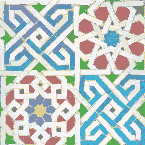Commercial Patterns
- Folkwear Patterns @ Lark Books
- Some great Near and Middle Eastern patterns. If you don't want
to draft your own, Folkwear makes some patterns that you can use - quite
a number of tunics, some vests and coats, and several different styles
of pants, even a burnous (Moroccan cloak). Most Folkwear patterns
include information on traditional (although not necessarily SCA
authentic) embroidery and decoration.
Check out the Caravan/Ethnic Collection:
- Gaza Dress - a basic T-tunic in several sizes. Although there's a woman on the package, this can be worn by anyone.
- Egyptian Shirt - can be lengthened for a tunic. I use
the shaped yoke - it looks similar to those in Persian after Mongol
"contact" - but avoid the lotus and papyrus applique - it's definitely
NOT period.
- Syrian Dress - T-tunic with "diamond" shaped yoke
- Turkish Coat - very useful garment
- Sarouelles - three different styles for men and women - narrow and poofy (also spelled sarawal and serouel in literature).
- Moroccan Burnoose - a North African cloak, traditionally worn by men.
- Algerian Suit - actually late period Turkish.
- West African Robe & Trousers
Yoruba Tunic & Trousers
- if you have a West African persona. And even if you don't, check out
the pants - they're rather typical of men's pants from all over the
Muslim world
- Afghani Nomad Dress - a favorite of mine for mundane wear, although i don't think it's documenTABLE summary="" in period.
From the Asian/Oriental Collection:
- Jewels of India - good for the kamisa. The other garments are either very late period or not period.
- South Asian Tops & Wraps - may be useful, for women only, includes a modern choli.
- Tibetan Panel Coat - good for Central Asians
- Chinese Jacket - adapTABLE summary="" for Persians, Mongols and other Central Asians, as well as Chinese personae
- Chinese Skirt - probably not period, but intriguing
- Hong Kong Cheongsam - NOT period
- Japanese Field Clothing - i dunno if they're period, but they can be worn by men and women and they're comforatable.
- Japanese Kimono - adapTABLE summary="" for men and women - depth
of sleeves changes with gender, class, and time period. You will likely
need to adjust them.
- Japanese Hapi & Haori - again unisex garments, made for wearing over kimono, may need some slight adjustments depending on your time period
- Japanese Hakama - those pleated pants worn by both courtly men and women in period.
- Japanese Interior - great for outfitting your tent, and now on sale, as this pattern has been discontinued.
From the Children's Collection:
- Little Folks - eight patterns and a variety of optional
handwork techniques for a Japanese Kintaro, Mexican Dress and Baby Shirt
(basic tunics with nice detailing), Korean Booties, Nepali Chupa,
Moroccan Djellaba, and Turkish Tunic and Bloomers. Very useful and
covers ages from a couple months to a couple years.
- Child's Kimono & Vests - for kids with Japanese personae...
And from the Old Europe collection:
- Vests from Greece and Poland - for women and men.
- Shirts from Russian and the Ukraine - make without cuffs.
- Cossack Uniform - the back shaping on the coat is rather late, but this is adapTABLE summary="" for several cultural areas
- Hungarian Szur - mongo cool, but i don't know if it's period.
- Atira's Fashions Patterns - commercially made patterns, primarily for belly dancers.
- They are used by a number of SCA Middle Easterners - most are
not really authentic, but you've got to start somewhere (for example,
the set-in sleeves on most of these are *not* authentic in period).
- Atira's Fashions Patterns (Selected for the SCA)
- Atira's Fashions Patterns (the rest of them)
- Actually there are a few within the second group that are SCA-able too.
|
![]()

